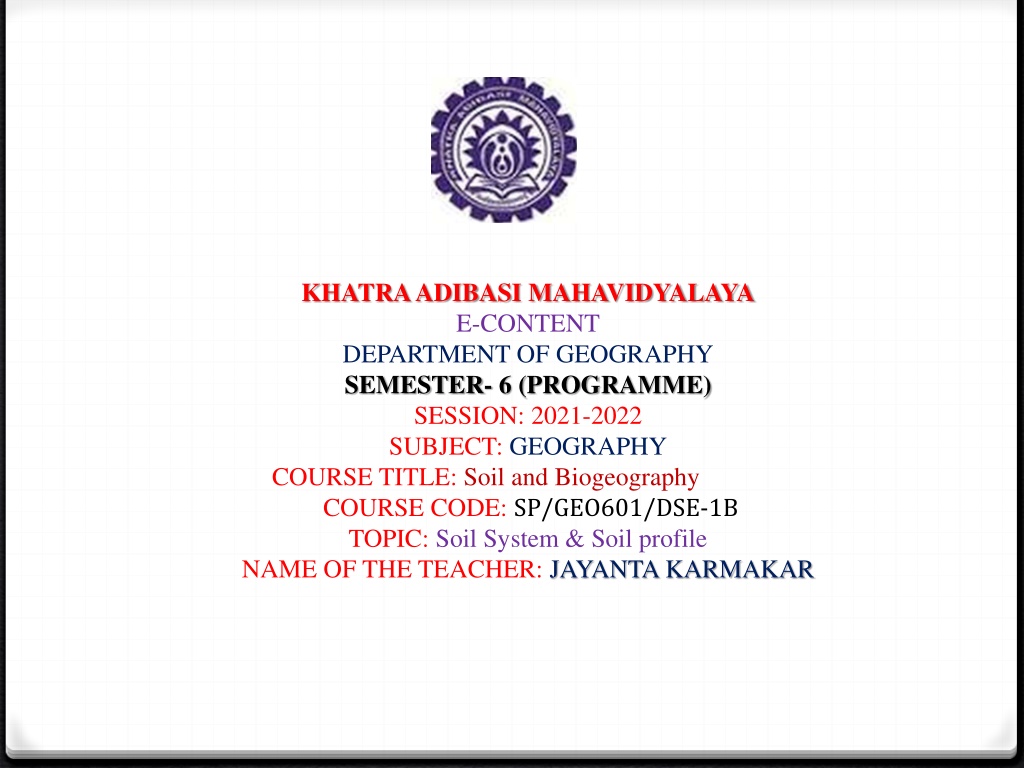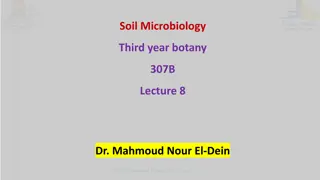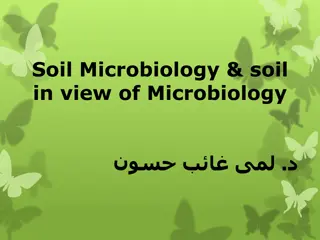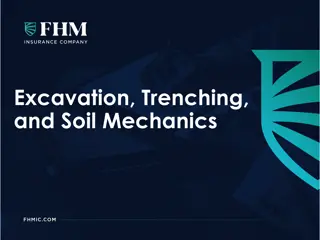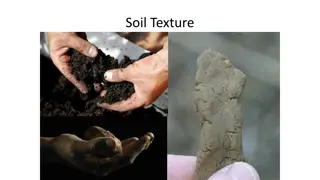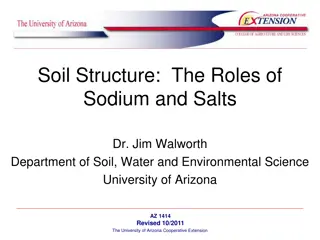Understanding the Importance of Soil Systems
Soils play a vital role in the Earth's ecosystems by forming at the interface of various elements like the atmosphere, lithosphere, biosphere, and hydrosphere. They consist of weathered bedrock, organic matter, air, and water, making them essential for sustaining life. Soil interactions with different components like the atmosphere, lithosphere, biosphere, and hydrosphere impact the water cycle, nutrient extraction by plants, and rock formation. The contrasting nature of different soils highlights their diversity and significance. Cultivated soil composition, humus, precipitation effectiveness, and zonal classification further underline the importance of soils in supporting plant growth and regulating water movement.
Download Presentation

Please find below an Image/Link to download the presentation.
The content on the website is provided AS IS for your information and personal use only. It may not be sold, licensed, or shared on other websites without obtaining consent from the author. Download presentation by click this link. If you encounter any issues during the download, it is possible that the publisher has removed the file from their server.
E N D
Presentation Transcript
KHATRA ADIBASI MAHAVIDYALAYA E-CONTENT DEPARTMENT OF GEOGRAPHY SEMESTER- 6 (PROGRAMME) SESSION: 2021-2022 SUBJECT: GEOGRAPHY COURSE TITLE: Soil and Biogeography COURSE CODE: SP/GEO601/DSE-1B TOPIC: Soil System & Soil profile NAME OF THE TEACHER: JAYANTA KARMAKAR
Unit 3: Human population, carrying capacity and resource use 0 3.4 The Soil System
The Soil System 0 Soils are major components of the world's ecosystems. 0They form at the interface of the Earth's atmosphere, lithosphere (rocks), biosphere(living matter) and hydrosphere (water). 0Soils form the outermost layer of the Earth's surface, and comprise weathered bedrock(regolith), organic matter (both dead and alive), air and water.
Interactions of Soil 0The Soil interact with the atmosphere, lithosphere, biosphere and hydrosphere. The water cycle moves through the soil by infiltration and water may evaporate from the surface 0The atmosphere may contain particulate matter that is deposited on the soils and particles may blow up into the atmosphere 0Rocks in the lithosphere weather to form soils, and soils at depth and pressure may form rocks 0Plants in the biosphere may extract nutrients from the soils and dead plants may end up forming parts of the soil
Importance of Soil 0 Soil : naturally occurring unconsolidated material on the surface of the earth that has been influenced by parent material from the rock below, climate, macro-organisms and micro-organisms. 0 Soils are complex systems which carry out a wide range of functions that are critical to the functioning of the Earth as a whole as a system
Importance of Soil 0 Typical cultivated soil: 50-60% mineral particles, 1-5% organic matter, & 40% pore spaces between the particles which will have varying amounts of air and water in them. 0 Zonal classification of soil : Climate factors 0 HUMUS: A dark crumbly substance that is very fertile for plant growth. 0 Precipitation effectiveness (Rainfall): is the balance between precipitation and potential evapotranspiration. Influences direction of water movement in soil, if precipitation is > Leaching
Soil Horizons 0 Vertical succession down through a soil 0Various layers in HORIZON s 0O: Leaf litter, humus, vital in soil fertility. 0A : Mixed organic layer , plant roots, decomposed organic material : Humus 0E: Eluvial or leached horizon (sand, silt with lost mineral and clay) 0B: Deposition or Illuvial horizon (iron, humus & Clay) 0C: Transition zone broken rock bed 0R: Parent bed rock (hard)
Process of soil formation 0 Three Process involved 0 Inputs 0Transformation 0Output
Inputs into a soil 0 Organic material from decaying flora and fauna 0Precipitation, gases and solid particles from the atmosphere 0Gases from the respiration of soil fauna 0Excretion from plant roots 0Minerals from the breakdown of parent material
Outputs from the soil 0 Nutrient taken up by plants growing in the soil. 0 Nutrient losses through leaching 0 Losses of soil through soil erosion and mass movement (e.g. soil creep) 0 Evaporation
Soil Texture 0 Refers to size of solid particles in a soil 0 Mineral composition is made up of 3 components: CLAY, SILT & SAND 0 Relative proportion of each component gives the soil texture. 0 Ref: as SOIL SEPARATES types of soil have specific range of soil particle size. 0Sand particles are sub divided into FIVE from very fine to coarse.
Soil Separates Name of soil separates CLAY SILT Very fine Sand Fine sand Medium Sand Coarse Sand Very Coarse Sand 1.00-2.00 Size (diameter/mm) USDA <0.002 0.002-0.05 0.05-0.10 0.10-0.25 0.25-0.50 0.50-1.00
Soil texture 0 Affects: 0Moisture content and aeration 0Retention of nutrients 0Ease of cultivation 0 root penetration of crops and other vegetation
Sandy Soils 0 Poor structure, gritty in nature and lack in cohesion 0 Feel dry compared to loam and clay soils 0 Free draining, dry out rapidly 0Lack nutrients washed out by downward movement of water 0 Advantage: a. Easy to cultivate light in nature 0 b. Warm up quickly in spring helps to provide a longer growing season. 0Management of the sandy soils often ignored in agriculture.
Loam Soils 0 Has greater cohesion than sandy, hold together better when a handful is picked up. 0Soft and rich in touch 0 Comprised of 40%-40%-20% of sand, silt and clay 0It is considered to be the perfect soil. The texture is gritty and retains water very easily, yet the drainage is well. There are various kinds of loamy soil ranging from fertile to very muddy and thick sod. 0Contains more humus & nutrients than others, better infiltration and drainage 0 Loams may be wet in winter as water table raises but are well drained in summer
Clay Soils 0 Heaviest of the three soils, fine particles resulting in few air spaces give the soil a very high level of cohesion. 0Clay drains poorly and feels lumpy and sticky when it is very wet 0Often sticks to footwear and tools in gardens 0Feels smooth not gritty, heavy to cultivate - forms clods that are difficult to separate 0Consist of 50% of clay particles, attract positively charged particles calcium, potassium & magnesium 0Slow draining can lead to water logging
Summary & comparison : Types of Soils Characteristics Sandy Soil Loam Soil Clay Soil Mineral Content High High Intermediate Drainage Very Good Good Poor Water holding capacity Low Intermediate High Air spaces Large Intermediate Small Biota & Potential to hold organic matter Primary productivity Low High Intermediate Low High Intermediate
Soil Degradation 0 Is a global process, involves both the physical loss (erosion) and the reduction in quality of topsoil associated with nutrient decline and contamination 0Impacts significantly on agriculture, urban environment, pollution and flooding 0Loss of upper soil horizon containing organic matter and nutrients 0Thinning of soil profiles reduces crop yields on degraded soils. 0The GLOBAL ASSESSMENT OF HUMAN-INDUCED SOIL DEGRADATION (GLASOD) undertakes global soil survey
Process of Soil degradation 0 Main cause soil removal of the natural vegetation cover, leaving the surface exposed to the elements 0Deforestation and Overgrazing main problems 0Result of loss of vegetation lead to wing and water erosion 0Agricultural mismanagements lack of knowledge, short term gains 0Shifting cultivation without fallow periods 0Absence of soil conservation measures 0Cultivation of fragile or marginal lands, unbalanced fertilizers use and the use of poor irrigation techniques
Soil degradation as a result of: 0 Erosion by wind and water (80%) 0Physical degradation (loss of structure, surface sealing and compaction) 0Chemical degradation (changes in pH, acidification, and salinisation) 0Biological degradation (loss of organic matter and biodiversity) 0Climate and land use changes (may accelerate the above factors)
Biological Degradation 0 Heavy and sustained use of artificial fertilizers 0 Loss of organic matter reduces the soil aggregates which under the influence of rainfall may then break up Results in SOIL CRUST S reduced infiltration of water in to the soil 0 Increases the likelihood of run off and water erosion happening. 0Loss of structure compaction from agricultural machinery and cultivation in wet weather.
Chemical Degradation 0 Loss of nutrients or inorganic matter, salinisation, acidification, soil pollution and fertility decline. 0 Acid rain, Combustion of fossil fuels acidity 0 Salinisation arid areas, coastal zones 0SOIL TOXICITY municipal and industrial wastes, oil spills, excessive use of fertilizer, herbicides and insecticides, or release of radioactive materials, acidification by airborne pollutants
Consequences of Soil Degradation 0 Desertification 0Salinisation 0Acidification 0Dust storms 0 Severe drought
Soil Degradation threat to food security? 0 Reduced food supply 0 Reduced farming income 0 Higher food prices 0 Increased malnutrition 0 Rural to urban migration
Soil conservation measures 0 Soil Conditioners materials added to soil to improve soil fertility. 0Wind reduction techniques Shelterbelts, hedgerows, Strip cultivation 0 Cultivation Techniques: Contour ploughing, Terracing 0Converting land from arable to pastoral uses. 0Crop rotation include grasses 0Leaving unploughed grass strips between ploughed fields 0 Selecting and use of machinery, alter harvesting
Comparisons of No-till, Conservation Tillage & Conventional Tillage
Comparison of Conservation tillage & Conventional
